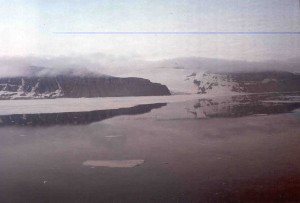The photograph to the left shows the coast of Greenland as seen from the Northeast water polynya.
Dissolved organic material (DOM) in the Arctic ocean has the highest concentration in any ocean basin, but is mostly unknown on the molecular level. DOM is potentially an important factor in supporting the net heterotrohic open ocean in the Arctic. An increased riverine inflow has been suggested as a consequence of global warming and points to the importance of determining the role of riverine DOM in the Arctic carbon cycle. The Shelf-Basin Interaction model suggests a possible transport mechanism for DOM from the shelf to the open Arctic Ocean. My group has started compound-specific studies of DOM in the Arctic Ocean to:
- determine whether the high DOC concentrations in the Arctic Ocean include a higher concentration of biologically labile components than are found in other oceans.
- determine the relative biological lability of DOM from riverine inputs to the Arctic Ocean and compare to relative lability of DOM formed in situ.
Specifically, amino acids, neutral aldoses and low-molecular-weight organic acids will be studied. Analysis will be carried out with IC-PAD for neutral aldoses, with HPLC-Fluorescence for amino acids and with HPLC-Fluorescence/UV-Absorbance for organic acids. The presently available methods for organic acid analysis suffer from high practical detection limits due to poor sensitivity and contamination problems, therefore the initial work will be focused on developing a new method for organic acids.
In order to determine the background concentrations of biologically labile compounds in the Arctic Ocean, samples from the Arctic will be collected with ships of opportunity and these concentrations will be compared with values found in the Atlantic and Pacific Oceans. In order to answer the question of biological lability of riverine organic matter, samples from the McKenzie River will be obtained. The relative concentrations of biologically degradable components (normalized to DOC) will be compared with Arctic Basin water. The values for biological lability of DOM in different locations in the Arctic will be very valuable information for modeling studies of the Arctic ecosystem.
This research is supported by the Office of Polar Programs at the National Science Foundation, Grant # OPP-9815705
Related publications
- Skoog A., Lara R.J., Wedborg M. and Kattner G., 2001. Spring-summer cycling of DOC, DON and inorganic N in a highly seasonal system encompassing the Northeast Water Polynya, 1993. Deep-Sea Research I 48: 2613-2629.
- Daly K.L., Wallace D.W.R., Smith W.O., Skoog A., Lara R., Gosselin M., Falck E., and Yager P., 1999. Non-Redfield carbon and nitrogen cycling in the Arctic: Effects of ecosystem structure and dynamics. Journal of Geophysical Research – Oceans. 104(C2):3185-3199.
- Wedborg M., Hoppema M., and Skoog A., 1998. On the relation between organic and inorganic carbon in the Weddell Sea. Journal of Marine Systems 17: 59-76.
- Lara R.J., Rachold V., Kattner G., Hubberten H.W., Guggenberger G., Skoog A, Thomas D., 1998. Dissolved organic matter and nutrients in the Lena River, Siberian Arctic: Characteristics and distribution. Marine Chemistry 59 (3-4), 301-309.
- Thomas D.N., Lara R.J., Eicken H., Kattner G. and Skoog A., 1995. Dissolved organic matter in Arctic multi-year sea ice during winter: major components and relationship to ice characteristics. Polar Biology (15):477-483.
- Anderson L., Olson K. and Skoog A., 1994. Distribution of dissolved inorganic and organic carbon in the Eurasian basin of the Arctic Ocean. In: The Polar Oceans and their role in shaping the global environment, eds R. Muench and O.M. Johannessen, pp. 255-262, American Geophysical Union, Washington, D.C.
